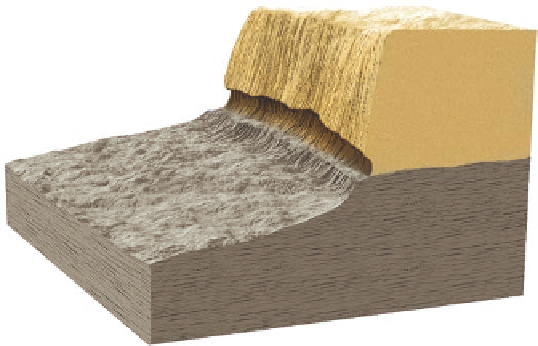Geoscience Reference
In-Depth Information
bonds, which, in turn, causes the sand grains within the rock
to separate slowly from one another. These loosened grains
are then washed or blown away by the water or wind, forming
a niche at the contact between the two rock types. Although
salt-crystal growth is a small-scale process, it has contributed
greatly to the evolution of landscapes in the canyons of the des-
ert Southwest by creating large niches and cave-like recesses in
cliff walls.
1
Flow of water
seeping through
rock
2
Cliff face
Water evaporates
3
Mineral salts deposited,
blown away by wind,
and niche forms
Sandstone
(permeable)
Exfoliation
Another way in which rock physically weathers is
when it expands through the process of
unloading
. Unloading
occurs when deep rocks are slowly uncovered because overlying
rock gradually erodes off of them. As the overlying rock mass
is gradually removed, the amount of compression on the deeper
rocks progressively lessens. If unloading progresses to the point
where the formerly deep rocks become surface rocks, they may
expand so much that curved joints develop parallel to the sur-
face. These joints are called
sheeting structure
and result in the
flaking of loosened rock from the main rock mass in a process
called
exfoliation
(Figure 14.9). Although unloading may be
the dominant cause of exfoliation, the process is probably en-
hanced by daily and seasonal temperature cycles that cause the
rock to expand and contract.
Exfoliation is most active in igneous and metamorphic
rocks, but also occurs in some sedimentary rocks. A great
place to see exfoliation on a large scale is Yosemite National
Park in California, where several large exfoliation domes oc-
cur in granite monoliths. The most famous of these landforms
is
Half Dome
, which towers over the adjacent Yosemite Valley
(Figure 14.9b). A close look at this peak reveals the curved
sheeting structure associated with exfoliation.
Sh
al
e
(im
p
er
me
a
ble
)
Figure 14.8 Salt-crystal growth and niche formation.
Salt-
crystal growth is most prominent where permeable sandstones
overlie relatively impermeable shales. As a result, water seeps
out at the contact between the two rock types, and salt-crystal
growth in the sandstone creates a niche.
Salt-Crystal Growth
Another kind of physical weathering
process is
salt-crystal growth
, which involves the buildup of
salts on rock surfaces. Salt is a dispersing agent, and its concen-
tration subsequently causes the minerals that cement the sedi-
ment grains within the rock to weaken their bonds; this, in turn,
loosens sediment so that it can then be eroded. This process is
similar to frost action in that it requires the presence of water
moving within rock.
An excellent place to see the effects of salt-crystal growth
is in the steep cliffs of the southwestern United States, where
permeable sandstones often overlie relatively impermeable
shales (Figure 14.8). Water stored within the sandstones tends
to move downward fairly easily because these rocks have large
pore spaces. This moving water easily dissolves salts such as
halite (sodium chloride), calcite (calcium carbonate), or gyp-
sum (calcium sulfate). When this downward-moving water
meets the shale, it can no longer move vertically and thus flows
horizontally toward the cliff wall, where it seeps out and rapidly
evaporates.
As a result of this evaporation, salts build up on the rock
surface at the contact between the sandstone and shale. This
high concentration of salts dissolves the cementing mineral
Chemical Weathering
Rocks are also altered by
chemical weathering
. In contrast to
physical weathering, which causes rock simply to break apart
into smaller fragments, chemical weathering decays the rock by
changing its chemical composition. This decomposition occurs
through the interaction of air, water, biological processes, and
rock minerals in various ways. In particular, water is very im-
portant as a weathering agent because of its ability to dissolve
minerals. As a result, chemical weathering is typically more
active in warm, humid environments (see Figure 14.1) where
abundant water is present and various chemical reactions freely
occur. Several chemical weathering processes are common,
each having a unique combination of environmental variables
that cause rock to decompose.
Salt-crystal growth
A weathering process involving the
buildup of salts on rock surfaces through evaporation. These
salts weaken the cement that bonds rock particles, allowing
them later to be washed or blown away.
Exfoliation
Form of physical weathering in which sheets of
rock flake away due to seasonal temperature changes or by the
expansion of the rock due to unloading.
Chemical weathering
The decomposition and alteration of
rocks due to chemical actions of natural physical and biological
processes.






































